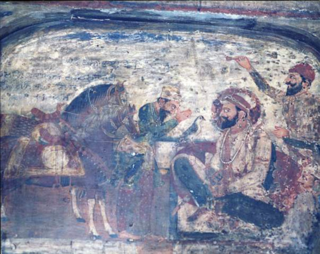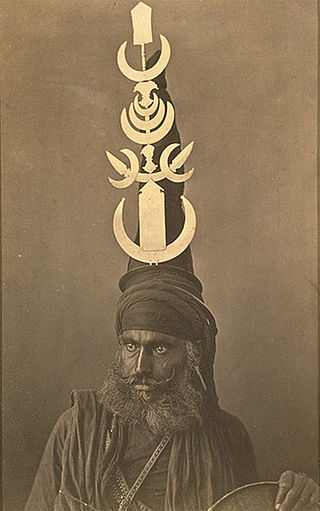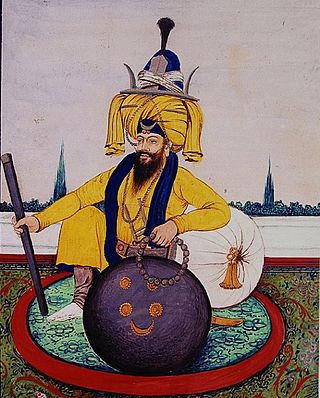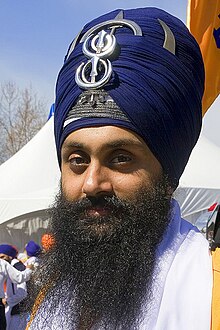
A turban is a type of headwear based on cloth winding. Featuring many variations, it is worn as customary headwear by people of various cultures. Communities with prominent turban-wearing traditions can be found in the Indian subcontinent, Southeast Asia, the Middle East, the Balkans, the Caucasus, Central Asia, North Africa, West Africa, East Africa, and amongst some Turkic peoples in Russia.

Khalsa refers to both a community that considers Sikhism as its faith, as well as a special group of initiated Sikhs. The Khalsa tradition was initiated in 1699 by the Tenth Guru of Sikhism, Guru Gobind Singh. Its formation was a key event in the history of Sikhism. The founding of Khalsa is celebrated by Sikhs during the festival of Vaisakhi.

In Sikhism, the Five Ks are five items that Guru Gobind Singh, in 1699, commanded Khalsa Sikhs to wear at all times. They are: kesh, kangha, kara, kachera, and kirpan.
Adherents of Sikhism follow a number of prohibitions. As with any followers of any faith or group, adherence varies by each individual.

The Nishan Sahib in Sikhism is a triangular flag made of cotton or silk cloth, with a tassel at its end. The current form of the Nishan Sahib that is in use throughout Gurdwaras around the world has an orange (saffron) background color that has the Khanda symbol in the center of the flag. It is commonly hoisted on a tall flagpole outside Gurdwaras.

The Nihang or Akali, also known as Dal Khalsa, is an armed Sikh warrior order originating in the Indian subcontinent. Nihangs are believed to have originated either from Fateh Singh and the attire he wore or from the "Akal Sena" started by Guru Hargobind. Early Sikh military history was dominated by the Nihang, known for their victories where they were heavily outnumbered. Traditionally known for their bravery and ruthlessness in the battlefield, the Nihang once formed the irregular guerrilla squads of the armed forces of the Sikh Empire, the Sikh Khalsa Army.
Dal Khalsa was the name of the combined military forces of 11 Sikh misls that operated in the 18th century (1748–1799) in the Punjab region. It was established by Nawab Kapur Singh in late 1740s.

A dastār is an item of headwear associated with Sikhism and Sikh culture. The word is loaned from Persian through Punjabi. In Persian, the word dastār can refer to any kind of turban and replaced the original word for turban, dolband (دلبند), from which the English word is derived.

Fateh Singh, commonly referred to with honorifics as Baba Fateh Singh or Sahibzada Baba Fateh Singh, was the fourth and youngest son of Guru Gobind Singh.

Kachera are an undergarment for the lower body that is specially tailored for shalwar with a tie-knot naala or naada (drawstring) worn by fully initiated Sikhs. They are similar to European boxer shorts in appearance. It is one of the five Sikh articles of faith called the Five Ks, and was given from Guru Gobind Singh at the Baisakhi Amrit Sanskar in 1699. Kachera have been worn by initiated Sikhs (Khalsa) since a mandatory religious commandment given by Guru Gobind Singh, the tenth Guru of Sikhism, in 1699. Both male and female Sikhs wear similar undergarments. This is one of five articles of faith—collectively called "Kakkars"—that form the external, visible symbols clearly and outwardly displaying one's commitment and dedication to the order (Hukam) of the tenth master.

Bidhi ChandChhina was a Sikh religious preacher and military commander, from Chhina Bidhi Chand village, 37 kilometers south of Amritsar and Chhina Bidhi Chand was part of Amritsar District not Lahore. His birth place temple is situated in his own village Chhina Bidhi Chand, which was built by the residents with the help of Baba Daya Singh. Baba Daya Singh laid foundation with his own hands. Every year on his birthday Baba Daya Singh, and now Baba Avtar Singh, would go to village Chhina Bidhi Chand and celebrate it there to date. He was a disciple of Guru Arjan and served Guru Hargobind for most of his life.
The following list consists of concepts that are derived from both Sikh and Indian tradition. The main purpose of this list is to disambiguate multiple spellings, to make note of spellings no longer in use for these concepts, to define the concept in one or two lines, to make it easy for one to find and pin down specific concepts, and to provide a guide to unique concepts of Sikhism all in one place.

Headgear, headwear, or headdress is any element of clothing which is worn on one's head, including hats, helmets, turbans and many other types. Headgear is worn for many purposes, including protection against the elements, decoration, or for religious or cultural reasons, including social conventions.
Sikhism was founded in Punjab in 1469 by Guru Nanak on the foundations that everyone is equal, regardless of caste, age, or gender. Both men and women are supposed to follow the Five Ks: Kesh, Kangha (comb), Kara, Kachera and Kirpan, and there was never a distinction between what a woman should be allowed to do versus a man at theological level. Men and women are treated equally in the temple (gurdwara), and everyone eats and prays side-by-side. Both men and women are meant to carry the Kirpan with them as they are responsible for their own physical protection, and should not depend on others. Sikhs are strictly against the caste system and many chose to use Kaur or Singh as a last name to push against the problematic caste system in India. There is only one god (Waheguru) in Sikhism and they are without form or gender, and everyone is equal in the eyes of God. Many Sikh women believe that this absence of assignment of code of conduct for a woman versus a man proves that their religion is historically committed to gender equality. Presently, the culture does not always follow these traditions and equality is often more true in ideals rather than daily practice. According to Kiman Kaur: "It is essential to take into account the diverse Kaur narratives in order to critically understand the violence Sikh women experience due to religious, ethnic, and gender minoritization through enabling more intersectional conversations."

Dastar bunga, or "towering fortress", is a style of turban used by a specific sect within the Sikhs, the Akali Nihangs. As an essential part of their faith the warriors used the turban as a store for their expansive range of weapons.

Binod Singh, a Trehan Khatri and a descendant of Guru Angad, was an army man and disciple of Guru Gobind Singh and was among few Sikhs who accompanied him to Nanded in 1706. In Budha Dal Chronicles, Guru Gobind Singh made Baba Binod Singh the head of the Khalsa.

Baba Darbara Singh, also known as Diwan Darbara Singh, was second Jathedar of Budha Dal and third leader of the Akal Takht. He should not be confused with other Darbara Singh of Sirhind who fought in the Battle of Anandpur.

History of clothing in the Indian subcontinent can be traced to the Indus Valley civilization or earlier. Indians have mainly worn clothing made up of locally grown cotton. India was one of the first places where cotton was cultivated and used even as early as 2500 BCE during the Harappan era. The remnants of the ancient Indian clothing can be found in the figurines discovered from the sites near the Indus Valley civilisation, the rock-cut sculptures, the cave paintings, and human art forms found in temples and monuments. These scriptures view the figures of human wearing clothes which can be wrapped around the body. Taking the instances of the sari to that of turban and the dhoti, the traditional Indian wears were mostly tied around the body in various ways.

Mughal clothing refers to clothing worn by the Mughals in the 16th, 17th and 18th centuries throughout the extent of their empire. Much of them were already being used in the past centuries before their arrival in Indian subcontinent. It was characterized by luxurious styles and was made with muslin, silk, velvet and brocade. Elaborate patterns including dots, checks, and waves were used with colors from various dyes including cochineal, sulfate of iron, sulfate of copper, and sulfate of antimony were used.

Sikh sects, denominations, traditions, movements, sub-traditions, also known as sampardai in the Punjabi language, are sub-traditions within Sikhism that believe in different approaches to practicing the religion. All sampradas believe in the One Creator God typically rejecting both idol worship and caste systems. Different interpretations have emerged over time, some of which have a living teacher as the leader. The major historic traditions in Sikhism, states Harjot Oberoi, have included Udasi, Nirmala, Nanakpanthi, Khalsa, Sahajdhari, Namdhari Kuka, Nirankari and Sarvaria.

















